(1) Measurements, Computations, and Exceptions
(a) Distance Measurements
Unless otherwise expressly stated, distances specified in this code are to be measured as the length of an imaginary straight line joining those points.
(b) Lot-Area Measurements
The area of a lot includes the total horizontal surface area within the lot's boundaries.
(c) Reductions in Area Prohibited
No lot, yard, court, parking or other space shall be reduced in area or dimensions so as to make said area or dimensions less than the minimum required by this code; and, if already less than the minimum required by this code, said area or dimensions shall not be further reduced. Exceptions to this standard shall only be granted if a reduction is approved as part of a conservation subdivision, variance approval, or administrative waiver approval.
(d) Setbacks, Yards, and Lot Type Requirements
(i) Measurements
Setbacks refer to the unobstructed, unoccupied open area between the foundation or base of a structure and the property line (lot line) of the lot on which the structure is located. Setbacks shall not contain any structure except when in conformance with this code. See Figure 154.04-B.

(ii) Yards Required for Buildings
A yard or other open space required for a building shall not be included as part of a yard or other open space for another building.
(iii) Front Yard Exception
In any residential district, a front yard setback shall not be required to exceed the average front yard setbacks of the existing front yards within the same block and within 100 feet of the principal building. Modification of the front yard in accordance with this section will not create a nonconforming lot unless the lot or structure does not meet other applicable provisions of this code. See Figure 154.04-C.
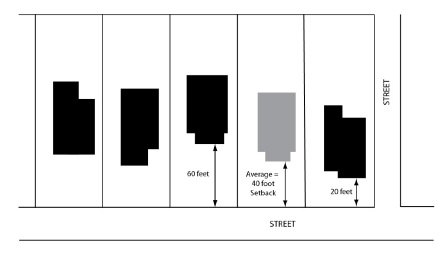
(iv) Permitted Obstructions in Minimum Required Yards
Every part of a required yard shall be open to the sky and unobstructed except:
A. As otherwise provided in this section;
B. For accessory and temporary uses as allowed in Section 154.06: Accessory and Temporary Use Regulations;
C. For landscaping as allowed in Section 154.09: Landscaping Standards;
D. For parking and circulation as allowed in Section 154.10: Parking, Access, and Mobility Standards;
E. For signage as allowed in Section 154.11: Sign Standards;
F. For the ordinary projections of skylights, sills, belt courses, eaves, cornices and ornamental features projecting into any yard a distance not to exceed 18 inches;
G. For the ordinary projections of chimneys and flues into any side or rear yard a distance not to exceed 18 inches; and
H. For open or lattice-enclosed fire escapes, fireproof outside stairways, and balconies opening upon fire towers projecting into a side or rear yard not more than 5 feet.
(v) Interior Lots
A. The required minimum front yard setback shall be measured from the street right-of-way or, where a right-of-way is not identified, the front lot line. See Figure 154.04-D.
B. The lot line located directly behind the rear of the structure, as determined by the Zoning Administrator, shall be the rear lot line and the rear yard setback shall be applied. See Figure 154.04-D.
C. All other lot lines shall be considered the side lot line and the side yard setback shall be applied. See Figure 154.04-D.
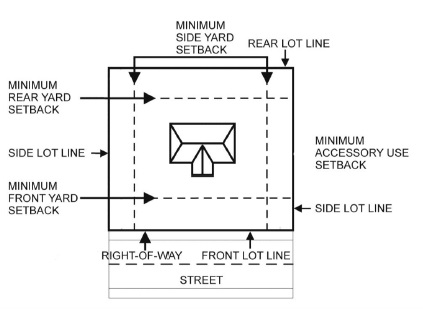
(vi) Corner Lots
Lots that have street frontage on 2 intersecting streets shall be considered a corner lot, subject to the following:
A. The required minimum front yard setback shall be provided from each street right-of-way or, where a right-of-way is not identified, the lot line adjacent to the street. See Figure 154.04-E.
B. The lot line that runs parallel with the lot line along the narrowest street frontage shall be the rear lot line and the minimum rear yard setback shall be applied from such lot line. See Figure 154.04-E.
C. All other lot lines shall be a side lot line and the minimum side yard setback shall be applied from such lot lines. See Figure 154.04-E.
D. The minimum lot area of a corner lot shall be 20% larger than the minimum area required for an interior lot.
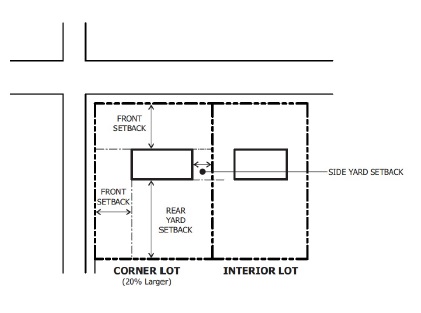
(vii) Double Frontage Lots
A. Where a lot is considered a double (through lot) lot, the required minimum front yard setback shall be provided on all lot lines that abut a street. See Figure 154.04-F.
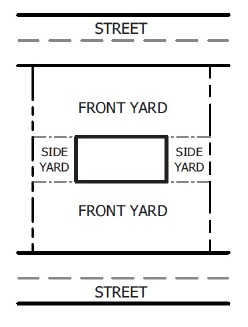
B. The remaining lot lines not abutting a public road right-of-way shall be considered as side yards and shall have the required minimum side yard setback provided for each side lot line. See Figure 154.04-F.
C. For the purposes of allowing accessory uses, including fences, that are allowed in a rear yard, the yard that is located to the rear of the principal building shall be considered the rear yard.
D. Where alleys exist in the city, any lots that have frontage along the alley shall not be considered a through lot and shall either be regulated as an interior lot or corner lot depending on the location of the subject lot within the block.
(viii) Panhandle Lots
Panhandle lots (flag lots) shall be discouraged and shall only be approved if necessitated by unique topographic features or other special physical conditions as deemed necessary by the Planning Board. Panhandle lots shall be subject to the following regulations:
A. Flag or panhandle lots shall not be used to avoid the construction of a street.
B. The stacking of panhandle lots shall be prohibited. See Figure 154.04-G.
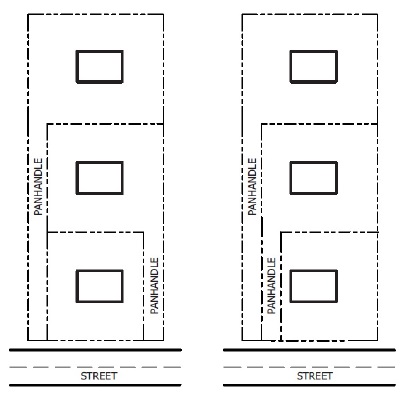
C. The panhandle shall have a minimum width of 20 feet along the entire width of the panhandle. The maximum width shall be 40 feet.
D. The minimum front yard setback requirement shall be measured from the lot line that creates the rear lot line of the adjacent lot as illustrated in Figure 154.04-H.
E. The panhandle portion of the lot shall not be used for storage nor shall any structures be permitted in such portion of the lot.

(ix) Cul-de-Sac or Curved-Street Lot
A. For a cul-de-sac lot or a lot abutting a curved street, the front-yard setback shall follow the curve of the front property line (lot line). See Figure 154.04-I.
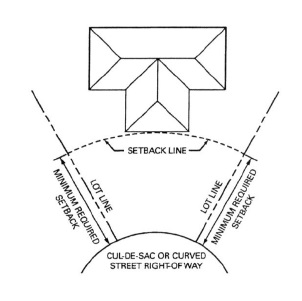
B. Lots on a cul-de-sac, including panhandle lots, shall be required to have a minimum lot width of 40 feet measured at the right-of-way line.
C. On a cul-de-sac roadway, knuckle, or eyebrow, the required 40-foot street frontage shall be required and measured at the street right-of-way on the curve of the cul-de-sac, knuckle, or eyebrow.
(x) Other Lot Configurations
Where there is an instance of a lot configuration not addressed in the previous sections (e.g., interior, corner, panhandle, etc.), or where there is an atypical building orientation on any lot, the Zoning Administrator shall have the authority to make a determination regarding where front, rear, and side yard setbacks are required.
(e) Lot Width and Street Frontage Measurements
Lot width is the distance between the side lot lines measured along the front yard setback line.
(f) Height Measurement and Exceptions
(i) Height Measurement
A. Where specified in stories, building height shall be measured in number of stories above the finished grade for any elevation fronting on a public street including attics, half-stories, mezzanines, and at-grade structured parking. This excludes features that are less than one-half story or completely below grade, such as basements, cellars, crawl spaces, sub-basements, and underground parking structures.
B. Where specified in feet, the building height shall be measured from grade to the highest point on the roof, regardless of roof type.
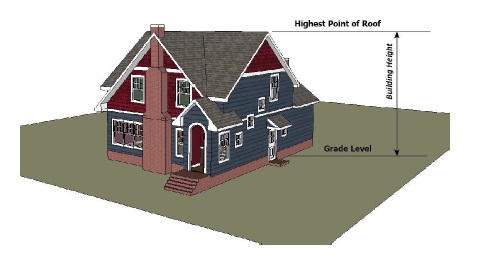
C. Where specified fencing and wall height shall be measured in accordance with § 154.06(A)(4)(i).
D. The height of all other structures shall be measured from the lowest grade adjacent to the structure to the highest point of the structure.
(ii) Exceptions to Height Limits
Height limitations stipulated in this code shall not apply to barns, silos or other agricultural buildings or structures on farms (not located in an improved platted subdivision); to church spires, belfries, cupolas and domes, monuments, chimneys, smokestacks, flag poles; or to parapet walls extending not more than 4feet above the limiting height of the building. The height limitations do not apply to other appurtenances usually required to be placed above the roof level and not intended for human occupancy except where the height of such structures will constitute a hazard to the safe landing and take-off of an aircraft at an established airport.
(2) General Site Development Standards
(a) Height Limit at Street Corners (Traffic Safety Visibility Triangle)
Development proposed adjacent to any public or private street, driveway, or alley intersection, in every district shall be designed to provide a clear visibility area for pedestrian and traffic safety in compliance with § 154.10(F)(4)(d)(i).
(b) Minimum Floor Area Requirements for Dwelling Units
In order to promote healthful living conditions and to stabilize the value and character of residential areas, dwelling units shall be erected, altered, moved, maintained and occupied only in accordance with the minimum floor area requirements established in Table 154.04-6. For the purposes of this calculation, the floor area shall include the total interior floor area of the applicable dwelling unit, excluding any floor area used for stairwells, elevator shafts, garages, basements that are not finished for use for human habitation, or any attached or detached accessory building or structure.
Zoning District | Use Type | Minimum Floor Area (Square Feet) |
Zoning District | Use Type | Minimum Floor Area (Square Feet) |
R-1A | Single Family Dwelling | 1,600 |
R-1B | Single Family Dwelling | 1,200 |
R-1C | Single Family Dwelling | 1,000 |
All Other Zoning Districts | Single Family Dwelling | 1,000 |
Two-Family Dwelling | 800 per unit | |
Multi-Family Dwelling (Studio or 1 Bedroom) | 550 per unit | |
Multi-Family Dwelling (2 Bedrooms) | 750 per unit | |
Multi-Family Dwelling (3 Bedrooms) | 950 per unit | |
Multi-Family Dwelling (4 Bedrooms) | 1,150 per unit | |
(3) Site Development Standards for Residential Zoning Districts
(a) Table 154.04-7 establishes the minimum site development standards for residential base zoning districts.
(b) There shall not be more than 1 principal building on an individual lot except as previously approved as part of an existing PD development or as part of an approved condominium project.
(c) Multi-family dwellings shall be considered as 1 building for the purpose of determining front, side, and rear yard requirements. The entire group as a unit shall be subject to the minimum setbacks for the applicable zoning district and lot type. Each individual building shall meet all yard requirements for the appropriate district as though it were on an individual lot.
Minimum Lot Area [1] (Square Feet) | Minimum Lot Width (feet) | Minimum Setbacks | Max. Building Height (feet) [2] | |||
Front Yard (feet) | Side Yard Each Side (feet) | Rear Yard (feet)
| ||||
Minimum Lot Area [1] (Square Feet) | Minimum Lot Width (feet) | Minimum Setbacks | Max. Building Height (feet) [2] | |||
Front Yard (feet) | Side Yard Each Side (feet) | Rear Yard (feet)
| ||||
R-1A Suburban Residential District | ||||||
Narrow Lot Development | 20,000 | 100 | 40 | 10 | 50 | 35 |
All Other Principal Use Types | 120 | 40 | 15 | 50 | ||
R-1B Neighborhood Residential District | ||||||
Narrow Lot Developments | 12,000 | 80 | 35 | 7 | 40 | 35 |
All Other Principal Use Types | 100 | 35 | 10 | 40 | ||
R-1C Urban Residential District | ||||||
Narrow Lot Developments | 9,000 | 65 | 30 | 5 | 35 | 35 |
All Other Principal Use Types | 80 | 30 | 10 | 35 | ||
R-2 Two-Family Residential District | ||||||
Two-Family Dwellings | 11,000 | 80 | 35 | 10 | 30 | 35 |
Other Principal Use Types | 8,500 | 75 | 30 | 8 | 30 | |
R-3 Multi-Family Residential District | ||||||
Two-Family Dwellings | 10,000 | 80 | 35 | 10 | 30 | 35 |
Multi-Family Dwellings | 4,000 per unit | 100 | 40 | |||
Zero Lot Line Dwellings | ||||||
Other Principal Use Types | 10,000 | 80 | 35 | 10 | 30 | |
NOTES: [1] Larger lot areas may be required if the lot is a corner lot, by a use-specific standard, or by the city or Miami County Public Health in cases where there is no access to a public sanitary sewer system. [2] Building heights are the maximum heights except as provided in § 154.04(H)(1)(f). | ||||||
(4) Site Development Standards for Nonresidential Zoning Districts
(a) Table 154.04-8 and Table 154.04-9 establish the minimum site development standards for all nonresidential base zoning districts, including the business and special zoning districts.
(b) There can be more than 1 principal building on an individual lot. When multiple principal buildings are located on an individual lot, the spacing between the buildings shall be reviewed and approved during site plan review to ensure an adequate amount of building spacing and preservation of landscaping areas.
Districts | Minimum Lot Area | Minimum Lot Frontage (Feet) | Maximum Building Height (Feet) |
Districts | Minimum Lot Area | Minimum Lot Frontage (Feet) | Maximum Building Height (Feet) |
OS - Office Service District | 10,000 Square Feet | 80 | 35 |
GB - General Business District | 10,000 Square Feet | 80 | 45 |
HB - Highway Business District | 20,000 Square Feet | 150 | 50 |
CC - Community Center District | None | None | 45 |
LI - Light Industrial District | None | 100 | 70 |
LD - Legacy Development District | None | None | 50 |
GI - General Industrial District | None | 100 | 70 |
CD - Conservation District | 10 Acres | 300 | 35 |
DISTRICTS | Front Yard (feet) | Lot is Adjacent to a Nonresidential use or District [1][2] | Lot is Adjacent to a Residential District [1] | |
Rear Yard (feet) | Side Yard (Each Side) (feet) | Rear Yard or Side Yard (Each Side) (Feet) | ||
DISTRICTS | Front Yard (feet) | Lot is Adjacent to a Nonresidential use or District [1][2] | Lot is Adjacent to a Residential District [1] | |
Rear Yard (feet) | Side Yard (Each Side) (feet) | Rear Yard or Side Yard (Each Side) (Feet) | ||
OS - Office Service District | 25 | 35 | None | 25 |
GB - General Business District | 25 | None | None | 25 |
HB - Highway Business District | 50 | None | None | 50 |
CC - Community Center District | None | None | None | 10 |
LI - Light Industrial District | 50 | Equal to the Height of Principal Building [3] | 50 | |
LD - Legacy Development District | None[4] | Equal to the Height of Principal Building [3] | 20 | |
GI - General Industrial District | 50 | Equal to Two Times the Height of the Principal Building [4] | 100 | |
CD - Conservation District | 100 | 100 | 50 | 100 |
NOTES: [1] Additional setback requirements may also be required as established in Section 154.09: Landscaping Standards or Section 154.10: Parking, Access, and Mobility Standards. [2] Where there is no minimum setback requirement but the building is set back from a lot line, the minimum distance for such setback shall be 4 feet. [3] The minimum side and rear setback for special uses shall be equal to 2 times the height of the principal building. [4] The minimum side and rear setback for special uses shall be 100 feet. | ||||
(Ord. 5-14, passed 3-17-2014)